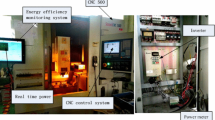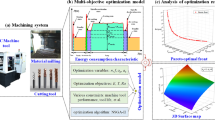Abstract
Aiming at the problem of low machining efficiency caused by the constant feedrate set by craftsmen in CNC machining, a feedrate optimization method by effectively combining the allowance optimization and the constant power constraint is developed in this paper. Firstly, the paper presents a machining allowance optimization method and corresponding hierarchical solution strategy to calculate machining allowance distribution. Then, a milling power prediction model is established on the basis of the milling force model and its accuracy is verified by the power model verification experiments. Furthermore, a feedrate optimization method with the spindle constant power constraint and a principle of secondary fine optimization are proposed. Finally, the allowance optimization of the complex part is carried out to obtain the positioning parameters and the optimal machining allowance distribution of the blank. Based on the machining allowance optimization results, the effectiveness of the feedrate optimization method is verified by the complex part machining optimization experiments. The experimental results show that the real-time power is maintained within the range of [−5.88%, 7.31%] of given target power value, reaching constant power constraint. It significantly shortens the processing time, improves the efficiency by 26.88%, and reduces the cost under the premise of protecting the machine tool and cutter. In this paper, the integrated optimization process from the determination of the blank quality to the processing parameter optimization is systematically completed.

















Similar content being viewed by others
Data availability
Not applicable.
Code availability
Not applicable.
References
Zhou W, Zhu X, Wang J, Ran Y (2018) A new error prediction method for machining process based on a combined model. Math Probl Eng:1–8. https://doi.org/10.1155/2018/3703861
Rai JK, Xirouchakis P (2008) Finite element method based machining simulation environment for analyzing part errors induced during milling of thin-walled components. Int J Mach Tool Manu 48:629–643. https://doi.org/10.1016/j.ijmachtools.2007.11.004
Shen B, Huang GQ, Mak KL, Wang XC (2003) A best-fitting algorithm for optimal location of large-scale blanks with free-form surfaces. J Mater Process Technol 139(1-3):310–314. https://doi.org/10.1016/s0924-0136(03)00241-3
Zhang Y, Zhang DH, Wu BH (2015) An approach for machining allowance optimization of complex parts with integrated structure. J Comput Des Eng 2(4):248–252. https://doi.org/10.1016/j.jcde.2015.06.007
Wu X, Dai W (2016) Research on machining allowance distribution optimization based on processing defect Risk. Procedia CIRP 56:508–511. https://doi.org/10.1016/j.procir.2016.10.099
Bae SH, Ko K, Bo HK, Byoung KC (2003) Automatic feedrate adjustment for pocket machining. Comput Aided Des 35(5):495–500. https://doi.org/10.1016/S0010-4485(01)00195-6
Zhang C (2009) Off-Line feedrate optimization based on simulation of cutting forces. Key Eng Mater 407-408:408–411. https://doi.org/10.4028/www.scientific.net/KEM.407-408.408
Park HS, Qi BW, Dang DV, Park DY (2018) Development of smart machining system for optimizing feedrates to minimize machining time. J Comput Des Eng 5(3):299–304. https://doi.org/10.1016/j.jcde.2017.12.004
Beudaert X, Lavernhe S, Tournier C (2012) Feedrate interpolation with axis jerk constraints on 5-axis NURBS and G1 tool path. Int J Mach Tool Manu 57:73–82. https://doi.org/10.1016/j.ijmachtools.2012.02.005
Erkorkmaz K, Layegh SE, Lazoglu I, Erdim H (2013) Feedrate optimization for freeform milling considering constraints from the feed drive system and process mechanics. CIRP Ann Manuf Technol 62(1):395–398. https://doi.org/10.1016/j.cirp.2013.03.084
Beudaert X, Pechard PY, Tournier C (2011) 5-Axis tool path smoothing based on drive constraints. Int J Mach Tool Manu 51(12):958–965. https://doi.org/10.1016/j.ijmachtools.2011.08.014
Sun Y, Zhao Y, Xu JT, Guo DM (2014) The feedrate scheduling of parametric interpolator with geometry, process and drive constraints for multi-axis CNC machine tools. Int J Mach Tool Manu 85:49–57. https://doi.org/10.1016/j.ijmachtools.2014.05.001
Bharathi A, Dong J (2016) Feedrate optimization for smooth minimum-time trajectory generation with higher order constraints. Int J Adv Manuf Technol 82(5-8):1029–1040. https://doi.org/10.1007/s00170-015-7447-x
Jixiang Y, Deniz A, Yusuf A (2018) A feedrate scheduling algorithm to constrain tool tip position and tool orientation errors of five-axis CNC machining under cutting load disturbances. CIRP J Manuf Sci Tec 23:78–90. https://doi.org/10.1016/j.cirpj.2018.08.005
Baek DK, Ko TJ, Kim HS (2001) Optimization of feedrate in a face milling operation using a surface roughness model. Int J Mach Tool Manu 41(3):451–462. https://doi.org/10.1016/S0890-6955(00)00039-0
Baek DK, Ko TJ, Yang SH (2012) Fast and precision NURBS interpolator for CNC systems. Int J Precis Eng Manuf 13(6):955–961. https://doi.org/10.1007/s12541-012-0124-1
Zhang ZX, Luo M, Zhang DH, Wu BH (2018) A force-measuring-based approach for feed rate optimization considering the stochasticity of machining allowance. Int J Adv Manuf Technol 97(5-8):2545–2556. https://doi.org/10.1007/s00170-018-2127-2
Xiong Z, Wang MY, Li Z (2004) A near-optimal probing strategy for workpiece localization. IEEE Trans Robot 20(4):668–676. https://doi.org/10.1109/TRO.2004.829474
Sun YW, Xu JT, Guo DM, Jia ZY (2009) A unified localization approach for machining allowance optimization of complex curved surfaces. Precis Eng 33(4):516–523. https://doi.org/10.1016/j.precisioneng.2009.02.003
Sun YW, Wang XM, Guo DM, Liu J (2009) Machining localization and quality evaluation of parts with sculptured surfaces using SQP method. Int J Adv Manuf Technol 42(11):1131–1139. https://doi.org/10.1007/s00170-008-1673-4
Li P, Wang RS, Wang YX, Tao WY (2020) Evaluation of the ICP algorithm in 3D point cloud registration. IEEE Access 8:68030–68048
Shi XJ, Liu T, Han X (2020) Improved iterative closest point (ICP) 3D point cloud registration algorithm based on point cloud filtering and adaptive fireworks for coarse registration. Int J Remote Sens 41(8):3197–3220. https://doi.org/10.1080/01431161.2019.1701211
Safaeian HN, Miri M, Rashki M (2016) An enhanced simulation-based design method coupled with meta-heuristic search algorithm for accurate reliability-based design optimization. Eng Comput 32(3):477–495. https://doi.org/10.1007/s00366-015-0427-9
Sierra MR, Coello CA (2005) Improving PSO-based multi-objective optimization using crowding, mutation and 6-dominance. Lect Notes Comput Sci 3410:505–519
Da Y, Ge XR (2005) An improved PSO-based ANN with simulated annealing technique. Neurocomputing 63:527–533. https://doi.org/10.1016/j.neucom.2004.07.002
Altintas Y (2012) Manufacturing automation: metal cutting mechanics, machine tool vibrations, and CNC design. Ind Robot 31(1):B84. https://doi.org/10.1115/1.1399383
Liu N, Zhang YF, Lu WF (2015) A hybrid approach to energy consumption modelling based on cutting power: a milling case. J Clean Prod 104(1):264–272
Funding
This study is supported by the National Key R&D Program of China (No. 2020YFB1710400) and Natural Science Basic Research Plan in Shaanxi Province of China (No. 2021JM-054).
Author information
Authors and Affiliations
Contributions
Baohai Wu: supervision, conceptualization, methodology, resources, funding acquisition.
Yang Zhang: methodology, experimentation, data curation, writing-original draft.
Guangxin Liu: supervision, methodology.
Ying Zhang: supervision, reviewing, and editing.
All authors have read and agreed to the published version of the manuscript.
Corresponding author
Ethics declarations
Ethics approval
Not applicable.
Consent to participate
Not applicable.
Consent for publication
Applicable.
Conflict of interest
The authors declare no competing interests.
Additional information
Publisher’s note
Springer Nature remains neutral with regard to jurisdictional claims in published maps and institutional affiliations.
Rights and permissions
About this article
Cite this article
Wu, B., Zhang, Y., Liu, G. et al. Feedrate optimization method based on machining allowance optimization and constant power constraint. Int J Adv Manuf Technol 115, 3345–3360 (2021). https://doi.org/10.1007/s00170-021-07381-z
Received:
Accepted:
Published:
Issue Date:
DOI: https://doi.org/10.1007/s00170-021-07381-z




